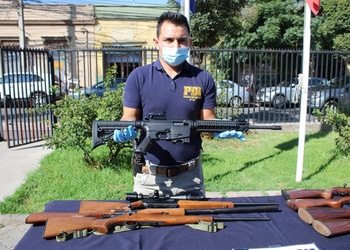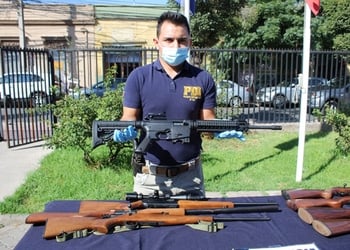As Ecuador reels from its worst prison massacre, military intelligence has recently revealed a flow of arms from Chile and Peru into Ecuador along its southern border, highlighting the country's key role in emerging arms trafficking routes.

A recent string of drug seizures, driven in part by increased enforcement, confirms police suspicions that Ecuador is a focal point for arms trafficking in South America. Police discovered ten heavy-caliber rifles during an August drug seizure in Guayaquil.
The weapons moving through Ecuador are imported from Chile, which in turn receives them from the United States, Europe and Asia. Traffickers smuggle them into Chilean ports. The arms are disassembled and concealed in shipments. A spike in recent seizures of this kind included the discovery of 30 dismantled AM-15 rifles from the US.
Ecuador serves as a critical transit point for arms moving from Chile into Colombia, as evidenced by a series of arrests in the border regions of Nariño and Carchi.
The main buyers of heavy weaponry in Colombia are dissident groups of the now demobilized Revolutionary Armed Forces of Colombia (Fuerzas Armadas Revolucionarias de Colombia - FARC). In February, an Ecuadorian gang that sold arms to the FARC was dismantled, with authorities seizing 1,299 cartridges of firearms and 155 magazines for AK49, Mig and Ruger rifles.
But weapons also find their way in the hands of Ecuadorian gangs. Several seizures of heavy-caliber weapons have been found in prisons controlled by the Choneros, Lobos and Lagartos, who have carried out much of the record violence this year.
In response to the exploding criminal economy, there are growing attempts at transnational enforcement. Both Colombia and Ecuador's police are prioritizing enforcement in the border regions. The Peruvian, Colombian and Ecuadorean authorities are collaborating on Operation Frontera Armada to halt the movement of guns.
InSight Crime Analysis
The stream of weapons moving through Ecuador exacerbates an already worsening security situation as its increasingly sophisticated gangs receive powerful weaponry.
Since 2020, gang violence has skyrocketed in Ecuador. What began as a war between the country's two most significant gangs, the Choneros and the Lagartos has since spiraled into a multi-faceted conflict fought to control drug trafficking inside and outside prisons. An additional factor is the reported presence of Mexican groups. According to Ecuador's former chief of military intelligence, Mario Pazmiño, the Sinaloa Cartel and Jalisco Cartel New Generation (Cartel Jalisco Nueva Generación - CJNG), who support different sides in the conflict to ensure their supply of cocaine, according to Ecuadorean authorities.
“The Mexican cartels of Sinaloa and Jalisco New Generation play an important role in drug trafficking in Ecuador. It's not that they are set up on Ecuadorian soil, but instead operate through local gangs," he told the Associated Press.
The Sinaloa Cartel had supported the Choneros when it was the dominant drug trafficking group in Colombia, the Washington Post reported.
Authorities are ill-equipped to deal with such a rise in violence, and weapons entering the country are only fueling this further.
This has also led to incidents where well-armed squads of hitmen have carried out daytime raids.
In other areas, a boom in illegal mining in the border provinces of Esmeraldas, Carchi, Sucumbíos and Imbabura is providing a key source of cash for gangs. The cross-border smuggling of fuel, drugs and people adds to this criminal gold rush.
Illegal mining has developed in part to replace the previously dominant criminal economy of supplying Colombia's FARC insurgency. Yet, with the return of arms trafficking this time to FARC dissident factions, Ecuador's gangs are expanding rapidly to take advantage of the many revenue streams available to them.
All this money and competition for control over border crossings and the drug trade will likely drive Ecuadorian demand for the very guns trafficked through the country and contribute to the nation's epidemic of violence, which has resulted in record-high homicide rates.
Source: InSight Crime





